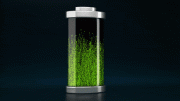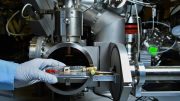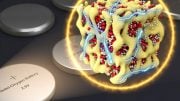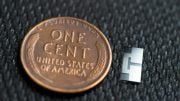
Although electric vehicle fires are not that common, when they do start, they can be very hard to put out. Scientists still trying to figure out all the details of what actually happens (chemically) when a lithium-ion battery catches fire.
Electric vehicles don’t catch fire often, but when they do, things get spicy. How do these fires start? And why are they so hard to extinguish? There are scientists trying to answer these questions, but there are also scientists still trying to figure out what actually happens (chemically) when a lithium-ion battery catches fire. Can we solve this problem without fully understanding what’s going on?
Video Transcript:
Electric vehicles don’t catch fire often, but when they do, things get spicy.
(funky music)
(reporter speaking in a foreign language)
This fire took 6,000 gallons of water to put out. And this one took almost 20,000.
So, how do these fires start and why are they so hard to put out?
To understand that, we can start by looking inside this nine-volt battery.
Turns out a nine-volt isn’t one battery. It’s actually six batteries. These individual batteries are called cells and an EV battery is the same.
It’s made of hundreds or thousands of cells like this one or this one, or even bigger ones that I couldn’t buy online for some reason.
A battery fire like this one starts in a single cell via a chemical process called thermal runaway. We actually have x-ray footage of this happening shot at thousands of frames per second.
This is the top of a cell similar to this one. Top nub thingy. Steel outer casing. The bright lines are metal oxides and copper. The dark parts are plastics and aluminum.
Okay, a closeup shot of the battery that’s shot even slower.
So, gas is building up here, which you can’t see directly, but it is shifting the internal components.
This thing right here, this is a pressure release valve, and, right now, it is rupturing, which should prevent an explosion by relieving the pressure, but watch this.
Gas buildup pushes the internal components of the battery upward, blocking the valve.
With nowhere to vent, more and more gas keeps building up and everything gets hotter and hotter and hotter, which stretches the steel outer casing to its breaking point until it fails and you get an explosion.
This is the aftermath. Complete devastation.
These white globs, this is molten copper. Copper melts at 1,085 degrees Celsius, so, inside this battery, you’ve got temperatures about as hot as a steel forge.
Now, if one cell thermally runs away, it can heat the surrounding cells to the point that they do too, and you got a chain reaction and it spreads to even more surrounding cells, and, pretty soon, you’ve got a massive battery fire.
There are groups of scientists and engineers trying to solve this problem, but there are also scientists just trying to figure out what’s actually happening chemically when a lithium battery catches fire. Because even after a few decades, we don’t fully understand it yet.
So, what do we know, and can we solve this problem without fully understanding what’s going on?
(funky music)
Here on “Reactions,” we’re gonna find out, after this word from our sponsor.
Do not do this at home. I’m a professional.
(playful music)
This is called the jelly roll.
This is the anode and it releases electrons.
This is the cathode and it absorbs them.
If you put these two in direct contact with each other, you’d get a spark, electrons jumping directly from here to here. But if you separate these layers with an electrically insulating layer and provide a path for the electrons via a couple of conducting layers, you can pull electrons out of the battery and make them do some work for you before they return to the battery again.
Now, the electrically insulating layer is called the separator, and it is key to understanding thermal runaway.
It’s electrically insulating, but chemically conductive, meaning electrons cannot pass through it, but lithium ions can.
Let that sink in for a second.
Electrons are point-like particles with zero volume. We made a whole video about this. You should definitely check it out. And a piece of plastic with lots of holes blocks them.
But ions are much larger, do have volume, as you can see from this highly accurate diagram I drew, and they can pass right through.
What’s going on?
Well, it actually has nothing to do with size.
Electrons are way too reactive to travel through materials on their own. They need a path and conducting materials like metals have lots of accessible empty orbitals that form exactly that path.
Plastics don’t.
So, even though the holes in a piece of plastic are way larger than an electron, there’s no conductive path around or through those holes.
Ions, on the other hand, they don’t need a path. They can just saunter right through.
So, anyway, the separator is made of plastic.
Now, let’s say that this little cell is humming along in an EV, and, for some reason, the cell starts to overheat.
Once the temperature in the cell reaches about 130 degrees Celsius, the separator melts, which means the anode and the cathode make direct contact and you get a spark.
This is called an internal short circuit or an ISC.
Quick side note here. Lots of things can cause an internal short circuit.
If you hammer a nail into the battery, for example, or if a charger malfunctions and overcharges the battery, or if you overheat the battery, or manufacturing defects.
What? I gotta put this back together if I’m gonna return it.
Okay, so if you wanted to design something that generates a complete chemical cluster (beep), a battery that’s just experienced an ISC is an excellent way to do it.
You’ve got a bunch of metals and metal oxides that are prone to give up or accept electrons. That’s why they’re in the battery to begin with. You’ve got solids in there, but you’ve also got liquids. You’ve got high temperatures, which means the liquids are prone to change into gases.
So now we have every phase of matter except plasma.
You’ve got a bunch of stuff that starts to decompose at higher temperatures. For example, metal oxides, when heated, tend to release oxygen gas.
That oxygen enables combustion reactions. Now those liquids and gases can burn, which generates more heat and more gases.
By the way, this is why EV fires are so hard to put out. Even though batteries are way less energy dense than gasoline, they generate their own oxygen when they burn.
Gasoline does not.
So, as long as the temperature is hot enough, the batteries can just keep reigniting unless you use thousands of gallons of water to bring the temperature down to the point where that can’t happen.
This whole situation is happening in an electrically-conductive environment, which makes it extra hard to keep track of the electrons and by extension the reactions.
So, basically, a complete and utter chemical cluster, to the point where there are entire journal articles that list the chemical reactions that are happening that we’ve discovered so far.
So this is the crux of the problem. It’s just really hard to untangle all of the chemistry that drives thermal runaway. So it’s hard to figure out a chemistry-centric way to stop it.
Also, battery tech is changing so fast that, even if you could totally untangle everything that’s happening in, for example, this type of battery, by the time you do, the industry’s moved on to a battery with a different cathode or separator material or whatever.
Despite all of that, though, we can say some really interesting things about thermal runaway, things that help us engineer against it.
Okay, look at this graph, which I have enlarged for your convenience, of temperature of a battery versus time.
As you can see, it happens slowly and then all at once. Now, this all at once bit right here, this is the main thermal runaway event.
Look at how fast that is. The temperature shoots up to its peak in about one second.
Now, the speed here tells us something really important about these reactions, and to understand what that is, we need to mix baking soda with room-temperature vinegar, and also with vinegar at 57 degrees Celsius.
The hot vinegar reacted much faster, and if you’ve ever cooked something, this makes sense. The hotter your pan, the faster the thing cooks.
Svante Arrhenius, a Swedish chemist living in the 1800s, developed a model to predict exactly how much faster a reaction would go at higher temperatures, and this is it, just one equation.
The important things are K, which you can think of as the speed of the reaction, and T up here in the exponent, that is temperature in Kelvin.
Now, suppose we wanted to compare the speed of a reaction at 298 Kelvin, which is about the temperature of a room, with the speed at 330 Kelvin, which is about the temperature of the hot vinegar.
What we do is we divide one rate constant by the other, and when you sub in this equation, you get this mess, and when you clean this up and rearrange some terms, you get this.
Now, let’s say the activation energy, which is just the energy required to get the reaction to go, is 150 kilojoules per mole. Pretty typical. Throw that in, crunch these numbers, and you get 350. The ratio of speeds is 350.
In other words, we’ve only increased the temperature here by about 30 Kelvin, roughly 10%, but the reaction happens 350 times faster, and that’s because of the temperature in the exponent.
When you increase temperature linearly, the speed tends to increase exponentially.
Now, here is a crazy wrinkle.
What happens when you have a reaction that gives off? Damn it.
What happens when you have a reaction that gives off?
When you have a reaction that gives off?
Is this just empty?
No.
Plenty.
What happens when you have a reaction that gives off?
(beep)
A bunch of heat?
You get what I like to call the Arrhenius ouroboros.
The reaction gives off heat, which increases the temperature. The increase in temperature means the reaction goes faster, which means it gives off heat faster, which means the temperature increases faster, which means it gets faster, which means it gives off heat even faster, which means the temperature increases even faster. which means it gets even faster.
This is a positive feedback loop, and, in particular, it’s an exponential positive feedback loop, which can drive the temperature in the battery from 200 to over a thousand degrees in half a second, and you get…
(funky music)
(reporter speaking in a foreign language)
By the way, this heat, it does dissipate, and it actually dissipates faster with increasing temperature, but that relationship is linear.
The exponential increase in reaction rate vastly overwhelms the linear increase in heat dissipation.
In the early days of lithium-ion, scientists knew a lot less than they know now, and yet they still manage to engineer solutions to problems they didn’t fully understand.
How?
Well, sometimes, solutions are obvious, don’t depend on the underlying chemistry, and are easy to do.
Batteries are exploding due to high pressure. Well, let’s build in a pressure-release valve.
Sometimes solutions are obvious in theory, but the chemistry is hard.
Separators melting?
Let’s engineer one with a higher melting point.
Easier said than done. Changing the melting point without changing other properties requires lots of trial and error, but we have been making progress. Separators today melt at much higher temperatures than they used to.
Sometimes the easiest, most obvious solution doesn’t solve the problem all the time.
Remember at the beginning when we talked about this X-ray footage?
Despite this pressure release valve functioning exactly as it should, the battery still exploded.
Sometimes the solution involves a layer of tech on top of the chemistry.
Software battery controllers monitor things like charge state and battery temperature, and, for example, shut down the battery when things are getting a little too hot.
And sometimes the solution involves throwing out the whole battery and designing a whole new one with a completely different ion, say, sodium.
One cathode material being tested for sodium-ion batteries is sodium chromite, which releases far less oxygen when heated than similar cathodes in lithium-ion batteries.
Less oxygen means less combustion, which means less heat, which means less potential for thermal runaway.
And for reasons we don’t really understand, sodium-ion batteries undergoing thermal runaway tend to release their energy a lot more slowly.
One study measured the rate of temperature increase for a typical lithium battery versus a sodium battery, and found that the lithium battery heated up almost four times faster than the sodium one.
That would give other safety features in the battery much more time to kick in and prevent an explosion.
Most of these solutions, pressure release valves, separators, different cathode materials, they don’t require full knowledge of every single chemical reaction happening during thermal runaway.
All they require is understanding, oh, the separator’s melting? Well, we should design one that doesn’t. The cathode is releasing oxygen? We should design one that doesn’t.
We can solve these problems before we finish understanding them, like this video.
I don’t really understand how we’re gonna end it, but we can solve that problem if I just keep talking and leave it up to Andrew to just end the credits whenever he sees fit, which could be now, or it could be now, or it could.









“Electric vehicles don’t catch fire often, …”
Where is the support for that claim? EVs may now have a penetration of about 10%, although the available information always seems to show the sunny side.
One frequently reads about EV fires, but rarely about ICE gasoline fires. Maybe they are too common to be considered news. However, I’m left with the impression that EV fires are disproportionately frequent, and certainly more challenging to contain. It remains to be seen what happens to the batteries after they are subjected to years of vibration and pothole bumps, and road salt.
I’m with you. The relatively low % is probably due to how new the technology. Gas tanks have a long history too, with risks and benefits clearly studied for decades. The last public scare I remember was the Pinto.
Meanwhile this video doesn’t address something I’ve learned. https://www.youtube.com/watch?v=74bOibOjNEw
Just wait for the flood of aging batteries. Anyone who has these 18650 li-ion cells (flashlights, vaping etc.) can tell you a story of at least one pouring smoke and sparks, and the cars use many thousands of them, all jam-packed for explosive thermal-runaway. Scitechdaily occasionally runs stories of companies using these batteries for electrical-grid storage, since they still can’t be recycled yet, and it’s a nightmare of unrelible fire-hazards. Electric cars are a brilliant concept, battery cars are not.
Hmm… the Tesla Model S uses 18650 cells and has been doing so since 2012. Yet no higher incidence of fire in those cars than other EVs. Which ARE lower than gas cars, which catch fire at a rate of about 100 per day. But it’s such a common thing that it’s never covered on the news. Every EV fire is covered though.
@Clyde Spencer,
There are plenty of websites to check, using real stats instead of personal impressions:
https://vedaing.com.mk/blog/statistics-vehicle-fire-causes/
https://www.statista.com/statistics/377006/nmber-of-us-highway-vehicle-fires/
ICE engineering and environmental issues are mostly considered ‘background’ issues and are not generally noticed due to being normalised. For example, all the drips of oil you see in car parks across the world, what volume do they add up to – where does the oil end up? All the oil changes required for engine and gearboxes – where does all that end up? You can be sure that only a small percentage of that oil is recycled. Oil consumption in EV’s are probably 1% of ICE’s.
EV’s are not green, but they are greener than ICE’s. The better solution is to reduce the need for private cars via better public transport and urban planning.
I do, however, agree that battery fires are a cause for genuine concern. The video shows that engineers are onto the problem. It’s a problem that must be solved if EV’s become a larger percentage of the vehicle fleet.
@Clyde Spencer,
Haha, I should’ve looked closer at my own link (1st one), which confirms your “impression” as being correct!
doh!
So they want to create large power grid scale batteries to capture wind and solar energy right? What happens when a battery pack several acres in size catches on fire?
These batteries are already in service around the world for several years. No big fire risk.
“Turns out a nine-volt isn’t one battery”
Actually, it is one battery. The D’s, C’s, AA’s and AAA’s, buttons, and coins are not batteries–they are cells. Of the common alkalines and lithiums that people buy, nine-volts are the only batteries. A battery is formed when two or more cells are connected together in one assembly, as in a nine-volt.
A car battery is a battery, since it has six lead-acid cells connected in series.
The new Encapsulator Agent category of suppressants as defined in NFPA 18A 7.7 and annex 4.7 handle Li-Ion fires much more efficiently and with much less water than described here.
Have a look at HCT F-500EA on YouTube
Here’s an old article that explains why the common misconception is that EVs catch fire often.
https://cleantechnica.com/2019/06/03/500-gas-car-fires-per-day-can-we-please-get-serious-about-electric-car-battery-fires/
Electric vehicle fires pose unique challenges when it comes to extinguishing them. The high-voltage lithium-ion battery packs in these vehicles are the main culprits. Unlike traditional gasoline fires, EV fires can reignite even after being initially put out. This is due to the thermal runaway effect, where the intense heat of the fire can trigger a chain reaction within the battery cells.
When salvaging electric vehicles, it’s important to consider safety and disposal procedures. If you’re interested in finding salvage vehicles like the Jeep Wrangler, salvage car auctions can be a great option. Jeep Wranglers are renowned for their ruggedness and off-road capabilities, making them a popular choice among adventure enthusiasts. If you’re curious about salvaged Jeep Wranglers and want to explore the options available, you can check out this link to view a selection of salvage Jeep Wranglers at car auctions: https://abetter.bid/en/car-finder/type-automobiles/make-jeep/model-wrangler. Remember to always exercise caution when dealing with salvage vehicles, and ensure that proper safety measures are followed throughout the process.
Electric vehicle fires pose unique challenges when it comes to extinguishing them. With their high-voltage batteries and complex electrical systems, these fires require specialized knowledge and equipment. Understanding this, it’s essential to explore reliable options like salvage Jeep Wranglers, known for their durability and off-road capabilities. Car auctions offer an opportunity to find affordable deals on salvage vehicles, including the iconic Jeep Wrangler. If you’re interested in exploring salvage Jeep Wranglers available at car auctions, check out this link https://abetter.bid/en/car-finder/type-automobiles/make-jeep/model-wrangler. It’s worth considering these options to meet your vehicle needs while being mindful of safety and value.